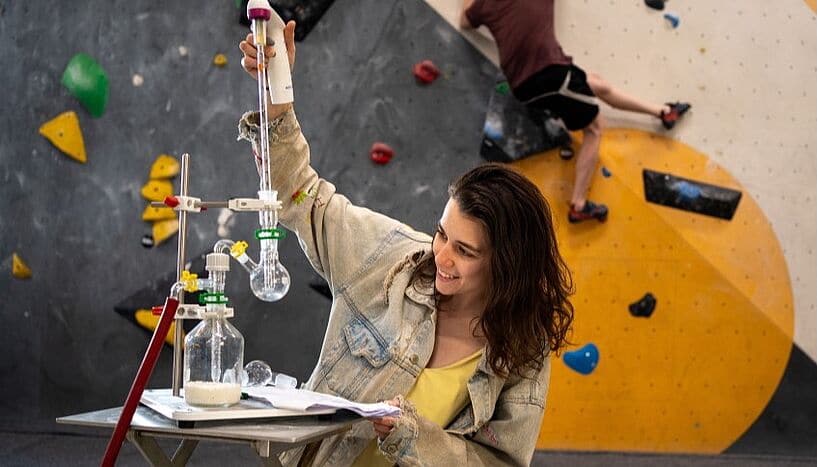This post was originally published on Eco Watch
In a new study, scientists are raising concerns over chemicals shed from climbing shoes in bouldering gyms. According to the study, abrasion from the shoes as they strike the holds can release chemicals into the indoor air breathed by climbers.
The researchers behind the study noted that climbing shoes are made with highly durable rubber made with additives, like car tires.
“The soles of climbing shoes are high performance products, just like car tires,” Anya Sherman, first author of the study, environmental scientist at the Centre for Microbiology and Environmental Systems Science (CeMESS) at the University of Vienna and hobby climber, said in a statement. In recent years, other studies have determined that car tires shed nanoplastics and can even be a greater source of emissions than modern vehicle tailpipes.
In the study, published in Environmental Science and Technology Air, scientists measured the rubber-derived compounds (RDCs) in 30 different pairs of climbing shoes and the air inside five different bouldering gyms in Vienna using the same methods that are used to analyze RDCs from tires.
“We were familiar with the black residue on the holds in climbing gyms, the abrasion from the soles of our shoes,” Sherman explained. “Climbers wipe it off to get a better grip, and it gets kicked up into the air.”
Anya Sherman uses an impinger (particle measuring device) to collect particulate matter from the air in bouldering gyms in Vienna. Aaron Kintzi / CeMESS
Following the tests, the researchers found that the climbing shoes contained 15 of the same chemicals that were present in car tires, including an additive known as 6PPD. As The Nature Conservancy reported, 6PPD can shed from tires and be swept off of roads through stormwater runoff. Once it reaches bodies of freshwater, it can cause salmon to die before spawning. However, impacts on human health from these chemicals still requires further research.
In addition to finding concerning compounds in the shoes themselves, the researchers also found high concentrations of the 15 RDCs in air samples and settled dust samples from the bouldering gyms.
“Air pollution in the bouldering gyms was higher than we expected,” said Thilo Hofmann, corresponding author of the study. “The levels we measured are among the highest ever documented worldwide, comparable to multi-lane roads in megacities.”
As a result, the researchers have estimated that climbers and gym employees could be inhaling and ingesting around 1.7 to 48 nanograms per kilogram per day.
Although the scientists are concerned about these chemicals in the air of gyms, they stressed that the gym staff they collaborated with for the study were eager to help reduce RDCs and improve indoor air quality, and the team noted that manufacturers may not be fully aware of how these shoes designed for high performance may also impact air quality and, potentially, climber health.
While Sherman plans to continue climbing and feels hopeful that improvements will be made, the team emphasized a need for more research on potential health impacts and education on risks.
“These substances do not belong in the air we breathe,” Hofmann said. “It makes sense to act before we know all the details about the risks, especially with regard to sensitive groups such as children.”
The post Climbing Shoes Can Release Potentially Harmful Chemicals Into the Air of Bouldering Gyms, Study Says appeared first on EcoWatch.





0 Comments